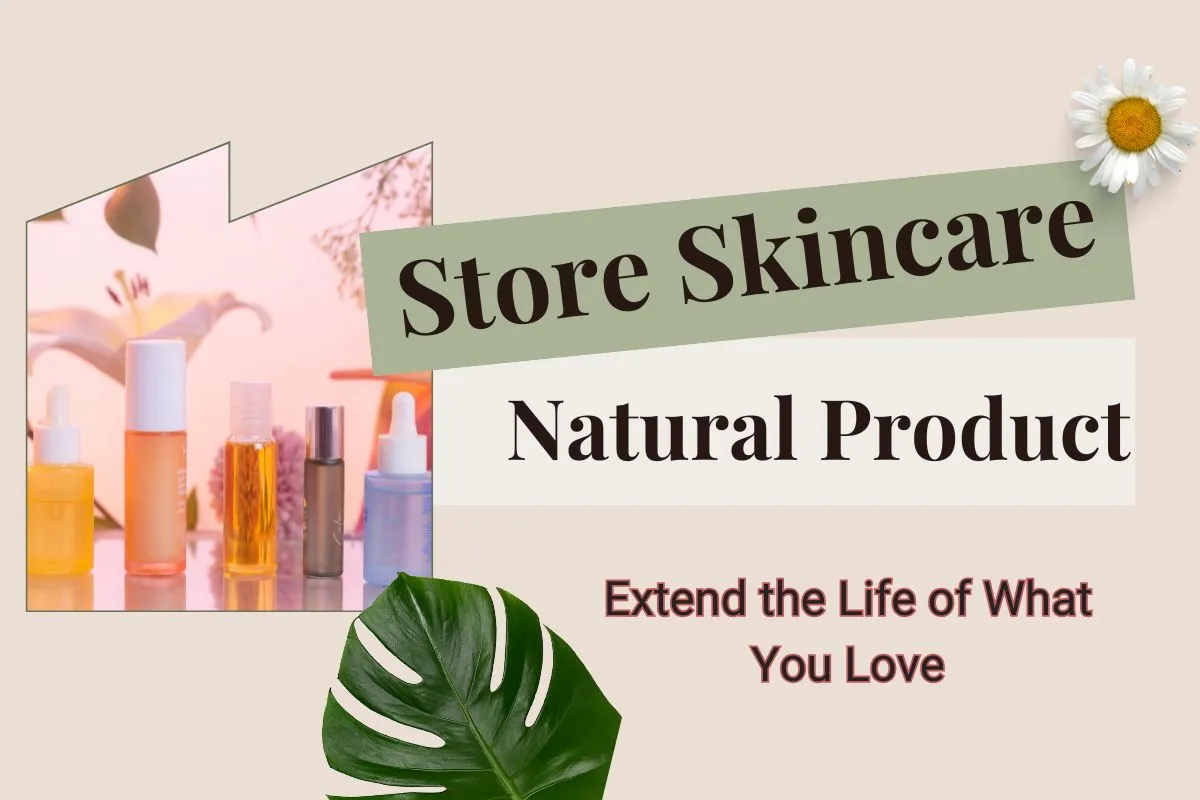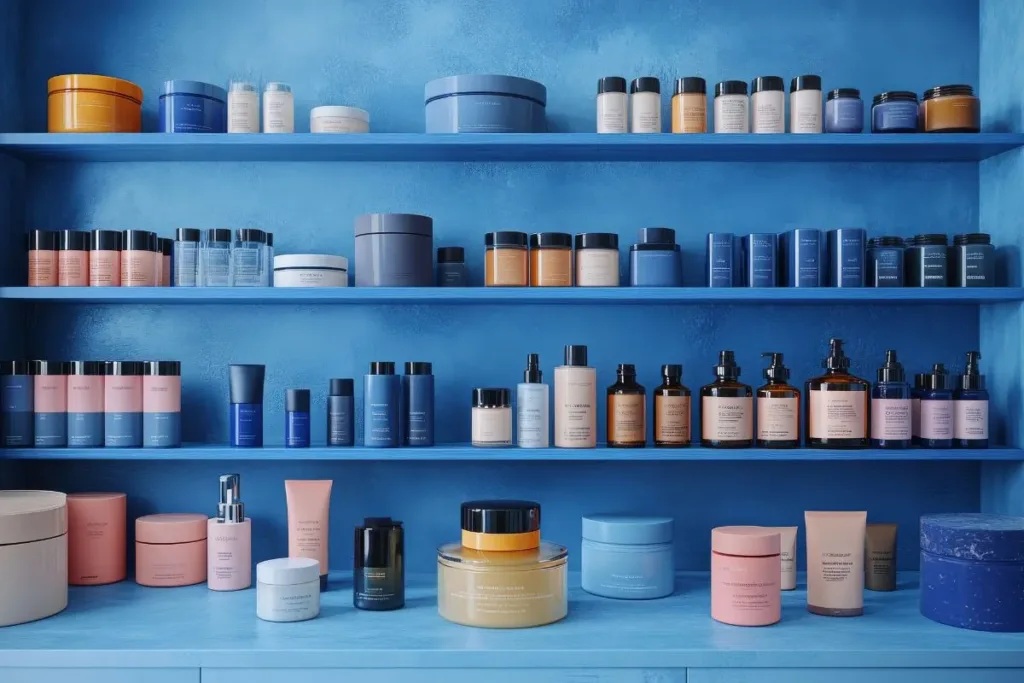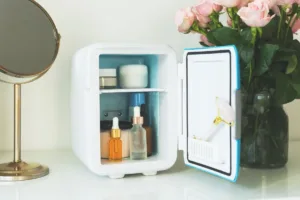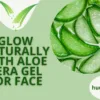No products in the cart.

When it comes to natural skincare, freshness isn’t just a luxury, it’s a necessity. Whether you’re reaching for a botanical-infused serum or applying a whipped shea butter cream, the potency of your fresh skincare products depends on more than just their ingredients, it hinges on how Storing Skincare products.. In the world of chemical-free beauty, understanding the shelf life of beauty products is the first step to protecting your skin and your investment.
But here’s the catch: unlike synthetic counterparts, homemade skin care supplies and natural formulations often skip the harsh preservatives. That’s what makes them gentle and effective but also more vulnerable to spoilage. What if your favorite product is already compromised and you don’t even know it? In this guide, you’ll uncover the secrets to storing skincare correctly, learn to decode expiration signs, and finally master your skin care shelf like a pro.
Ready to unlock the full potential of your natural skincare collection? Let’s dive in and protect your glow.
Don’t forget to explore Hudira’s line of preservative-smart products designed for longevity and purity.
Why Storage Matters: The Science Behind Skincare Shelf Life

When it comes to storing skincare, especially natural and fresh skincare products, storage isn’t just a suggestion, it’s essential science. Natural skincare formulations typically avoid synthetic preservatives, stabilizers, and fillers found in conventional cosmetics. While this makes them gentler and safer for sensitive skin, it also makes them more delicate and susceptible to degradation from environmental factors. Here’s a deeper look at the three main threats to your skincare shelf life:
1. Oxidation: The Enemy of Oil-Based Products
Oxidation occurs when natural oils and active ingredients are exposed to oxygen over time. This exposure initiates a chemical reaction that breaks down the oil’s structure, leading to rancidity, discoloration, and loss of therapeutic properties. For instance:
- Rosehip oil, rich in omega-3s, can turn sour quickly if not stored in a dark, airtight bottle.
- Vitamin C oxidizes rapidly when exposed to air and light, turning brown and losing its brightening effects.
Storage tip: Use airless pumps, amber bottles, and seal lids tightly after every use.
2. Microbial Contamination: Mold and Bacteria Love Moisture
Natural and homemade skin care supplies often include water-based ingredients like aloe vera, rose water, or herbal infusions perfect breeding grounds for bacteria, yeast, and mold if not properly preserved. This can result in:
- Spoilage (you’ll notice off smells, separation, or mold spots)
- Potential skin infections or allergic reactions
Even a clean-looking jar may harbor microbes introduced via fingers or air. This is why even “preservative-free” natural products still require safe handling and often natural preservatives like radish root ferment or vitamin E.
Storage tip: Always use clean spatulas or droppers and avoid storing products in humid bathrooms.
3. UV Degradation: Sunlight Destroys Active Ingredients
Just like your skin, your skincare products are vulnerable to sunlight exposure. UV rays break down sensitive ingredients, especially antioxidants like vitamin C, E, or plant extracts like green tea. This leads to:
- Fading color and fragrance
- Reduced potency
- Separation or crystallization in the formula
Storage tip: Keep products in dark-colored bottles and store them away from windows, ideally in a drawer or cabinet.
Why Does It All Matters?
When products degrade due to poor storage, they not only lose effectiveness, they can also become harmful. A serum that was once healing can now clog pores, trigger breakouts, or irritate your skin. Wasted products mean wasted money, and for skincare brands like Hudira, we aim to ensure every product you open is as potent and safe as it was on day one.
Typical Shelf Life of Beauty Products: What to Expect
Knowing the expected shelf life of beauty products can save your skin and wallet. Here’s a general breakdown:
| Product Type | Unopened Shelf Life | Opened Shelf Life |
| Oil-Based Serums (w/ Vit E) | 18–24 months | 6–12 months |
| Water-Based Creams or Gels | 12–18 months | 3–6 months |
| Clay Masks | 12–18 months | 3–4 months |
| Homemade skin care supplies | 6–12 months | 1–3 months |
| Natural Toners (e.g. rose water) | 6–12 months | 3–6 months |
Note: Always check for “PAO” (Period After Opening) symbols on your packaging (e.g. 6M = use within 6 months).
Signs Your Product Has Expired

Using expired skin care especially natural or fresh skincare products can do more harm than good. Without strong preservatives, these products are more prone to spoilage from heat, bacteria, and oxidation. Recognizing the warning signs of degradation helps protect both your skin health and your product investment. Let’s dive deeper into each signal:
1. Change in Smell
Your nose is one of the best indicators of a spoiled product.
- A natural product typically has a light, herbal, floral, or earthy scent, depending on its ingredients.
- Over time, especially with exposure to heat or air, these scents may turn sour, metallic, musty, or rancid, a telltale sign of oxidation or microbial activity.
Example:
A sweet almond oil-based moisturizer may begin to smell like cooking oil gone bad. This means the fats in the oil have oxidized.
What to do: If the smell is unpleasant or “off,” it’s safest to discard the product.
2. Texture Shift
Texture is another strong clue. Natural emulsions (like creams and lotions) are particularly sensitive to changes in temperature, air, and contamination.
Watch for:
- Separation: Water and oil layers no longer stay blended like salad dressing left untouched.
- Curdling or clumping: The product looks grainy or thickens unevenly.
- Grit or lumps: Indicates ingredient breakdown or contamination.
Example:
A clay-based face mask may start feeling lumpy or separated, making application uneven and ineffective.
What to do: Gently stir it, if it doesn’t re-blend smoothly, it’s time to toss.
3. Color Fading or Darkening
Color shifts often point to oxidation or UV damage:
- Vitamin C serums may turn from clear to yellow, brown, or orange.
- Herbal-infused oils (like turmeric or green tea) may lose their rich golden or green tones.
- Creams may darken, especially around the container’s rim.
Why it matters:
Color change means active ingredients may have degraded, making the product less effective—or even irritating.
What to do: Compare it to your original product photo or batch (if available). Any significant change is a red flag.
4. Irritation, Tingling, or Burning
Even if a product smells and looks fine, how your skin reacts is the ultimate test.
- A natural product should feel soothing or neutral on application.
- If you experience tingling, stinging, burning, redness, or itching, it might be due to ingredient degradation, microbial contamination, or even mold spores invisible to the eye.
Sensitive skin? You’re especially at risk with expired homemade skin care supplies or products without preservatives.
What to do: Wash it off immediately and discontinue use.
Final Rule: When in Doubt—Throw It Out
Natural skincare doesn’t always give clear expiration signs like food, but your senses and skin are strong indicators. Using expired products isn’t just ineffective—it can clog pores, trigger acne, worsen pigmentation, or cause allergic reactions.
Safety Tip: Keep a small skincare journal or use a marker to write the opening date on your product. Most products are safest within 3–12 months of opening, especially on a minimalist skin care shelf without refrigeration.
4. Best Practices for Storing Skincare

Natural and fresh skincare products are highly sensitive to their environment. Unlike commercial cosmetics, which are often filled with stabilizers and synthetic preservatives, natural products rely on gentler preservation methods making them more vulnerable to degradation. By following these storage best practices, you can extend the life, safety, and performance of every product on your skin care shelf.
i. Store in a Cool, Dry Place
Why it matters:
Heat accelerates chemical reactions and can destabilize emulsions (the mix of water and oil). Humidity invites mold and bacteria, especially in homemade skin care supplies or preservative-light products.
- Where to avoid: Bathrooms are often steamy and warm, not ideal for storing skincare.
- Recommended temperature range: 15–25°C (59–77°F), which helps maintain consistency and prevents active ingredients from breaking down prematurely.
Tip: Keep your skincare in a drawer, cabinet, or a dedicated cool vanity shelf away from heat sources like radiators or windows.
ii. Avoid Direct Sunlight
Why it matters:
UV rays can break down sensitive ingredients like vitamin C, retinol, essential oils, and plant extracts. This process, called photodegradation, not only diminishes the product’s efficacy but can also cause unwanted chemical changes, such as discoloration and pH shifts.
- Products in transparent packaging are especially vulnerable.
- Oils like rosehip and serums with botanical actives degrade faster in light.
Tip: Use opaque or amber-colored bottles and always store them in shaded areas (drawers, boxes, or dark shelves).
iii. Use Airtight, Dark Containers
Why it matters:
Oxygen and light are major enemies of natural formulations. Exposure leads to oxidation (especially in oil-based products) and allows bacteria and mold to thrive.
- Amber glass and airless pump bottles are ideal—they block UV rays and limit air exposure.
- Wide-mouth jars, though convenient, allow more air and bacteria in with each use.
Tip: If you transfer your products into different containers (e.g., when traveling), use sterile tools and avoid transparent plastic unless it’s UV-resistant.
iv. Keep Hands and Tools Clean
Why it matters:
Every time you dip your fingers into a jar, you’re introducing bacteria, skin cells, moisture, and oils that can contaminate your product and reduce its shelf life.
- Over time, this contamination leads to microbial growth even in preserved products.
- In homemade skin care supplies, this can become a safety risk due to their typically shorter shelf life and lack of strong preservatives.
Tip: Always use a small spatula, dropper, or clean spoon to take out product. Wash and dry your hands thoroughly if you must use fingers.
v. Refrigerate When Needed

Why it matters:
Some natural ingredients especially those prone to oxidation or microbial growth benefit from refrigeration. The cool temperature slows down bacteria, yeast, and mold growth, and stabilizes volatile actives.
Best candidates for refrigeration include:
- Vitamin C serumsAloe vera gels
- Eye creams (cooling helps de-puffing)
- Hydrosols or floral mists
- Clay masks (prevent drying out)
Important: Don’t freeze products. Freezing can alter texture, split emulsions, and ruin consistency.
Tip: Keep a small skincare fridge if you regularly use fresh, preservative-free items.
vi. Organize Your Skin Care Shelf
Make your skin care shelf work for you:
- Separate short-lived products (like small-batch or handmade ones) in a “use first” section.
- Keep a mini calendar or date label to track when each item was opened.
- Group products by skin care shelf life store oils and balms together, refrigerate hydrosols and vitamin serums, and keep powder masks dry.
Storage Tips by Product Type
| Product Type | Ideal Storage |
| Facial Oils | Dark glass bottle in drawer |
| Moisturizers | Room temp, avoid heat |
| Mists & Toners | Fridge for freshness |
| Masks (clay or cream) | Away from humidity |
| Balms & Butters | Cool place to prevent melting |
Natural Preservation: What Really Works?
While natural products don’t use traditional parabens, many use botanical preservatives such as:
- Vitamin E – delays oxidation in oils
- Rosemary Extract – antimicrobial, oil-soluble
- Leuconostoc/Radish Root Ferment – natural ferment preservative
- Sodium Benzoate + Potassium Sorbate – effective in low concentrations
At Hudira, we blend preservation smarts with ingredient purity ensuring our fresh skincare products stay safe without harsh chemicals.
Smart Labeling: How to Stay Organized
Pro tip: Use a permanent marker to label the date you open a product. Also:
- Track usage in a journal
- Group short-lived items separately
- Set reminders for discard dates in your phone
Your skin care shelf should be a zone of freshness, not clutter.
Hudira’s Commitment to Safe, Lasting Skincare
We’re passionate about blending tradition with safety. Every Hudira product:
- Comes in UV-safe and air-protective packaging
- Is crafted in small batches to ensure freshness
- Uses botanical preservatives for safe skin care shelf life
- Offers ingredient transparency so you know what you’re using
Shop confidently because your glow deserves nothing less.
FAQs
Q. Can I refrigerate all my skincare products?
Not all. Water-based items like toners or gels benefit from refrigeration, but oils may solidify and lose texture.
Q. How can I tell if a product is still good?
Check for changes in color, smell, or texture. If anything feels off or irritating, it’s best to discard.
Q. Are natural products less safe due to shorter shelf life?
Not at all—when stored properly, they’re perfectly safe and healthier for your skin barrier.
Q. What’s the difference between expiration date and PAO?
The expiration date applies to unopened items; PAO (e.g., 6M) shows how long you can use a product after opening.



Add comment